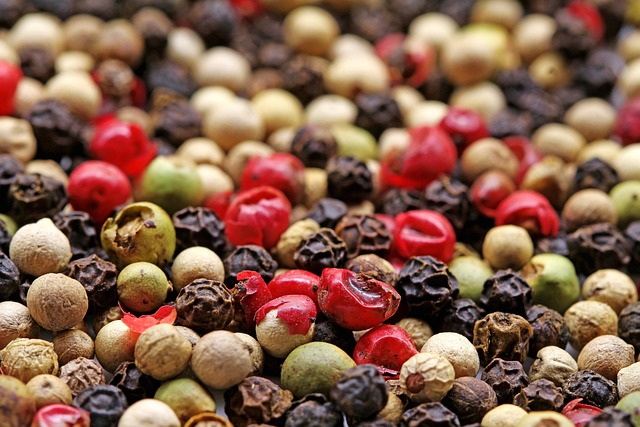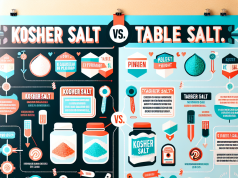Contents
White Pepper: The Secret Ingredient for Perfectly Seasoned Dishes
Are you looking to elevate your culinary creations with a touch of magic? Look no further than white pepper – the secret ingredient for perfectly seasoned dishes that will leave your taste buds tingling with delight.
White pepper, derived from the dried berries of the Piper nigrum plant, is a staple in many cuisines around the world. Its unique flavor profile offers a slightly hotter and spicier taste compared to its black counterpart, making it an ideal addition for those seeking an extra kick in their meals.
One of the main reasons white pepper is often favored by chefs is its ability to blend seamlessly into various dishes. Unlike black pepper, its pale color ensures that it doesn’t disrupt the appearance of light-colored sauces, soups, and creamy dishes, allowing them to maintain their pristine visual appeal while being flawlessly seasoned.
Additionally, white pepper possesses a subtle earthiness that complements a wide range of flavors, enhancing the overall taste profile of your dishes without overpowering other ingredients. Whether you’re preparing a delicate seafood dish or a rich and hearty stew, white pepper seamlessly harmonizes with different culinary creations.
Furthermore, white pepper offers numerous health benefits. It is known for its potential antibacterial and antioxidant properties, which may help boost your immune system and promote overall well-being. Its beneficial qualities, in addition to its tantalizing taste, make white pepper an excellent choice to incorporate into your daily cooking routine.
In summary, white pepper is the secret ingredient that can take your cooking to the next level. Its bold taste, versatility, and health benefits make it an essential addition to any kitchen pantry. So why settle for bland dishes when you can achieve culinary greatness with the magic touch of white pepper?
White Pepper: The Secret Ingredient for Perfectly Seasoned Dishes
What is White Pepper?
White pepper is a spice derived from the same plant as black pepper, Piper nigrum. However, it is processed differently, resulting in a milder and slightly sweeter flavor profile. It is made by removing the outer skin of fully ripened pepper berries, resulting in a white or light cream color.
Why Choose White Pepper?
White pepper offers a unique taste and aroma that sets it apart from its black counterpart. It has a more delicate flavor, making it particularly suitable for dishes where black pepper may overpower other ingredients. White pepper is often used in light-colored dishes such as cream-based sauces, soups, and mashed potatoes, as it doesn’t leave black specks behind.
Flavor Profile and Culinary Uses
White pepper has a distinctively earthy and slightly spicy taste with subtle floral undertones. Its flavor is less pungent compared to black pepper, allowing it to add a gentle kick to dishes without overpowering them. Apart from its use in soups, sauces, and mashed potatoes, white pepper is also popular in Asian cuisine, particularly in stir-fries, marinades, and certain noodle dishes.
Health Benefits of White Pepper
White pepper offers several potential health benefits. It contains several antioxidants that can help protect your body against damage caused by harmful free radicals. Additionally, white pepper has been found to possess anti-inflammatory properties, which may aid in reducing inflammation and associated health conditions. It also contains certain compounds that may help improve digestion and promote gut health.
Using White Pepper in Your Cooking
White pepper can be incorporated into your cooking in various forms. You can use whole white peppercorns and grind them yourself using a pepper mill or mortar and pestle. Alternatively, pre-ground white pepper is readily available in most grocery stores, providing convenience. However, it is worth noting that freshly ground white pepper tends to have a more intense flavor. Remember to store your white pepper in an airtight container away from direct sunlight to maintain its freshness and flavor.
Conclusion
White pepper is an essential spice that can elevate your dishes to new levels of flavor. Its distinctive taste and compatibility with an array of recipes make it a versatile ingredient worth exploring. Next time you’re in the kitchen, reach for that white peppercorn jar and experiment with this secret ingredient to create perfectly seasoned dishes that will impress your family and friends.
Related Post: The Benefits of Using Freshly Ground Spices in Cooking
Frequently Asked Questions: White Pepper
What is white pepper?
White pepper is a spice derived from the dried ripe berries of the Piper nigrum plant. It is mainly used to add flavor and heat to dishes.
How is white pepper different from black pepper?
White pepper is made from ripe berries that have had their outer skin removed, whereas black pepper is made from unripe green berries with the skin still intact. The removal of the outer skin gives white pepper a milder, more earthy and complex flavor compared to the sharper taste of black pepper.
What dishes is white pepper commonly used in?
White pepper is commonly used in various Asian cuisines, such as Chinese and Thai dishes. It is also a popular choice for seasoning light-colored sauces, soups, and creamy dishes where the strong black flecks of black pepper might be visually unappealing.
Can white pepper be used as a substitute for black pepper?
Yes, white pepper can be used as a substitute for black pepper, but it is important to note that the flavors are different. White pepper has a milder taste, so you may need to use a larger quantity to achieve the desired level of spiciness.
Should I choose ground white pepper or whole white peppercorns?
Both ground white pepper and whole white peppercorns have their uses. Ground white pepper is convenient for recipes that require a fine texture, such as sauces or marinades. Whole white peppercorns, on the other hand, are preferred in dishes where you want the spice to infuse gradually, such as in brines or stocks.
What is White Pepper?
White pepper, also known as Piper nigrum, is a popular spice widely used in culinary dishes around the world. It is derived from the matured berries of the pepper plant and gets its name from the white color of the outer shell. Unlike black pepper, which is made from the unripe fruit, white pepper is obtained by removing the outer layer through soaking and hulling.
The Distinct Flavor and Aroma
White pepper boasts a uniquely subtle yet robust flavor that is distinct from its black counterpart. It offers a slightly hotter and spicier taste, along with a mild earthy note. The aroma of white pepper is more delicate and less pungent compared to black pepper.
Culinary Uses of White Pepper
White pepper is commonly used in various cuisines around the world. Its versatility allows it to complement a wide range of dishes, including soups, sauces, marinades, and stir-fries. Due to its lighter color, white pepper is often preferred in dishes where dark specks of black pepper might be visually unappealing, such as in white sauce or mashed potatoes.
Health Benefits
Aside from enhancing the flavor of your favorite dishes, white pepper also offers several health benefits. It contains a compound called piperine, which has been found to possess antioxidant, anti-inflammatory, and anticancer properties. White pepper is also known for its potential to aid digestion, stimulate appetite, and assist in nutrient absorption.
Outbound Link to Wikipedia for More Information
To explore more about white pepper, please visit the White Pepper Wikipedia page.
White Pepper: The Secret Ingredient for Perfectly Seasoned Dishes
Benefits of White Pepper:
- Enhances the flavor of dishes without overpowering
- Subtle and delicate taste
- Brings out the natural flavors of ingredients
- Perfect for dishes that require a mild heat
Usage Tips:
- Grind freshly for maximum flavor
- Add towards the end of cooking to preserve aroma
- Use in sauces, soups, and creamy dishes
- Pairs well with vegetables, poultry, and seafood
Cautions:
- Can be overpowering if used in excess
- Not suitable for individuals sensitive to spicy foods
- Store in an airtight container to maintain freshness
- A little goes a long way – start with a small amount and adjust to taste








































